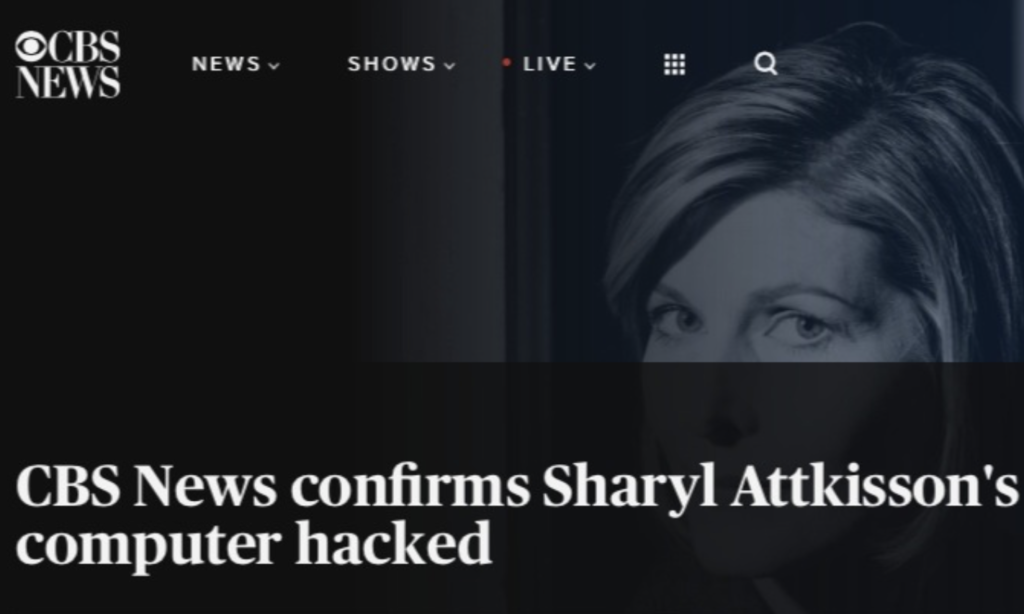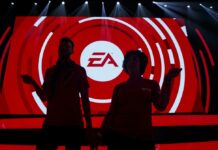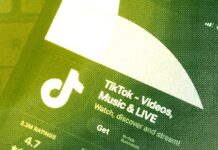As the Dept. of Justice continues to fight my attempt to seek justice in the government spy operation against me and my family, we filed an Affidavit today summarizing nearly a decade of attempts to pry information out of the hands of the government.
Currently, the DOJ is using your tax money to defend one of the accused agents, an ex-Secret Service agent who recently served time in prison for corruption charges in a separate crime.
Excerpt are below. You can read the latest court documents in full below beneath the excerpts.
(From Sharyl Attkisson affidavit dated June 13, 2023)
14. Between 1994 and 2014, I was employed by CBS News, including as an investigative journalist.
15. Two of my investigations conducted in the 2011 to 2013-time period, Fast and Furious and Benghazi, ultimately received national recognition for investigative reporting by both the International Emmy Awards and the Edward R. Murrow Awards.
16. Both investigations relied upon sources (whistleblowers or “leakers”) inside the Obama Administration who sought me out to expose corruption and falsities that were being told to the American public by our own government. Although my reporting was apolitical, the revelations naturally proved sensitive and embarrassing to certain individuals within the Obama Administration, as they would have for any Administration. As the documents later showed, my and our (CBS) reporting was considered influential and potentially extremely damaging to the Administration’s political standing.
17. The first of these investigations was about the government’s controversial, secret strategy of allowing thousands of weapons to be trafficked or “walked” into the hands of Mexican drug cartels, often with federal agents watching it happen. The largest known case that utilized this disputed strategy was an undercover operation known as Fast and Furious by the United States Bureau of Alcohol, Tobacco, Firearms and Explosives (“ATF”) under the United State Department of Justice (“DOJ”).
18. In May 2010, though it was not publicly known at the time, the DOJ secretly monitored Fox News reporter James Rosen as part of an investigation into who in the government was “leaking” information to him. As part of its probe, and with the personal approval of Attorney General Eric Holder, the government obtained secret warrants for Rosen’s personal email and phone information, and tracked his comings and goings to and from the State Department. To justify its actions and keep the warrants secret, the government labeled Rosen “a criminal co- conspirator,” and a “flight risk,” though he was never charged with a crime. When the Attorney General’s conduct was revealed three years later, the unprecedented actions against Rosen in the name of identifying a government “leaker” drew universal condemnation from First Amendment and civil rights advocates.
19. In December of 2010, a U.S. Border Patrol Agent named Brian Terry was murdered by Mexican cartel criminals near the border in the Arizona desert. The DOJ learned, but chose to keep secret, that the killers used weapons that had been trafficked under the watch of ATF agents in Operation Fast and Furious.
20. Although it was not public at the time, an internal email entitled “Obama Leak Investigations,” written by an executive at the government intelligence contractor Stratfor, dated September 21, 2010, four months after the actions against Rosen, stated that “Brennan1 is behind the witch hunts of investigative journalists learning information from inside the beltway sources. Note — There is specific tasker from the [White House] to go after anyone printing materials negative to the Obama agenda (oh my.)”
21. The disclosure of this internal document was shocking to everyone, especially the journalism community. The fact that the White House was directly implicated in a written communication with attacking journalists was shocking.
22. Shortly after, my first reports on Fast and Furious aired on the CBS Evening News in early 2011, when ATF inside sources stepped forward to expose the “gunwalking,” and its role in Agent Terry’s death, to both me and to Sen. Charles Grassley. My public reporting relied on confidential sources in the Obama Administration, as well as an exclusive interview with then- sitting ATF Special Agent John Dodson, who worked on a team ordered to “let guns walk”, and who personally revealed facts associated with the fiasco.
23. Immediately after our first report aired, though it was not publicly known at the time, officials in the Attorney General’s office, including General Holder and his chief aide Tracy Schmaler, exchanged sometimes frantic emails with other federal officials about me and my reporting. This is a proven fact because the emails were later publicly disclosed and showed that these officials made statements including, “We agree that it’s time to go on the offensive” (p. 79); “Not good” (p. 85); “NPR…said this is as big as Ruby Ridge” (p. 85); “Bad story coming on CBS Evening News tonight.”
24. In May 2011, though it was not publicly known at the time, the DOJ’s Patrick Deklotz authored an email instructing the Freedom of Information (“FOI”) group within DOJ to route all of FOI requests from me — through him.
25. After my October, 2011 report revealing that General Holder had received weekly briefings on the controversial Fast and Furious operation, contrary to his denials to Congress, General Holder aide Tracy Schmaler called me and literally yelled at me on the telephone, while White House spokesman Eric Schultz called and screamed and cursed me about our reporting at CBS.
26. Privately, on October 4, 2011, White House official Eric Schultz and General Holder aide Tracy Schmaler emailed about me: “She’s out of control” (p. 232) and “Her piece was really bad for [AG Holder].” This too became public much later when the emails were made pubic.
27. On October 5, 2011, General Holder emailed “Why don’t we…go on the offensive in ways I’ve been thinking.” (p. 239) That same day, Deputy AG Kevin Ohlson emailed General Holder, “This story is gaining traction. You need to stop it from snowballing — now.” These emails likewise became public information.
28. As I began reporting on Fast and Furious in early 2011, using ObamaAdministration whistleblowers or sources that were “leaking” information about the controversy, my family and I began to notice odd anomalies in our electronic devices, including my CBS laptop computer. These anomalies occurred wherever I was physically located so long as I was on the internet or had access to the internet, which, at my home meant via Verizon’s fiber optic service, FiOS.
29. On multiple occasions, including in February, 2012, I contacted Verizon to report and ask them to troubleshoot the ongoing anomalies. Repeated Verizon service calls did not fix the problems, which continued to escalate.
30. My reporting made international headlines and sparked an intense Congressional investigation. Although the DOJ and ATF initially denied the facts that we at CBS reported, officials later admitted, under oath, that they were 100% accurate. General Holder’s agency, the DOJ, ultimately issued a letter of apology to Congress for having provided false information early in the proceedings.
31. General Holder ultimately refused Congressional subpoenas to release key documents related to the scandal, and became the first sitting member of the Cabinet of the United States to be held in contempt of Congress.
32. My reporting and documents exposed, among other facts, secret audio recordings with an ATF agents discussing how “toxic” Special Agent John Dodson and his whistleblowing were proving to be and how damaging the case was to the F.B.I. (which was involved in the investigation of Agent Terry’s murder); allegations about a “missing” Fast and Furious weapon that had been in F.B.I. custody; the fact that hundreds of crimes, including murders, were being committed with the “walked” weapons on both sides of the U.S.-Mexico border; that General Holder had been repeatedly briefed about Fast and Furious, contradicting his sworn, Congressional testimony; documents showing ATF, DOJ, and the White House; including General Holder, his top aide, and a White House aide; expressing anger and alarm over my reporting and discussing ways, in internal communications, to stop or discredit it; and documents showing there were White House communications about the secret gunwalking operations after officials had denied any knowledge of them. Ultimately, President invoked executive privilege for the first and only time in his presidency to shield all related White House documents from Congressional or public view. In 2016, a federal court ruled that the documents withheld by President Obama were not covered by privilege. As a result, some additional documents were released to Congress in 2018, some seven years after the story first broke.
33. In the spring of 2012, the DOJ embarked upon an aggressive, new program of cyber-related strategies of an unspecified nature in the name of national security. This is publicly known because of an announcement later found on the DOJ website.2
34. During the same time frame (2012), however, it was not publicly known that the DOJ had secretly seized personal and work phone records belonging to journalists from the Associated Press (AP) news agency in violation of longstanding DOJ practice. The seizure was made as part of an investigation into who inside the government had “leaked” information to AP. As Americans later learned, the DOJ belatedly notified the AP months later, leading the agency to launch complaints and call the federal actions a “massive and unprecedented intrusion” into how news organizations gather the news.
35. In July, 2012, the DOJ initiated a policy designating its U.S. Attorneys’ offices to act as “force multipliers” in the agency’s stepped-up cyber efforts and use of unspecified cyber strategies, again all in the name of national security. This too was later discovered from a publication on DOJ’s website: https://www.justice.gov/archives/opa/blog/new-network-takes- aim-cyber-threats-national-security.
36. On October 5, 2012, CBS News aired my first in a series of investigative reports on the deadly terrorist attack on Americans in Benghazi, Libya. The series relied in significant part on Obama administration whistleblowers who voluntarily came forth to provide information that exposed critical lapses of the Executive Branch’s handling of the security requests at the U.S. compound in Benghazi, where U.S. Ambassador Christopher Stevens and three (3) other U.S. personnel were killed on September 11, 2012.
37. Three days later — on October 8, 2012 — CBS aired another of my investigative reports on Benghazi, including an interview with whistleblower Army Green Beret Lt. Col. Andrew Wood. Wood led an elite, 16-man counterterrorism team in Libya and documented the obvious risks and the U.S. State Department repeated denial of requests for better security prior to the attacks.
38. Those facts and others reported in my series contradicted numerous public statements made by Obama Administration officials, including President Obama, and proved politically embarrassing just weeks before the 2012 presidential election.
39. During the weeks following the airing of Col. Wood’s interview, numerous confidential sources in the federal government with links to intelligence agencies voluntarily came forth to inform me that efforts were being made within the Executive Branch to clamp down on “leaks” and to track the leaking of information to specific news reporters, including me personally.
40. That same month – October, 2012 – is when I and my family began noticing an escalation of our electronic device problems, including interference and interruption in our computers, mobile phone lines, land lines, and even television service.
41. It was during this time frame that several additional confidential government sources approached me privately and informed me that the Obama Administration was taking “unprecedented” actions against reporters and was likely monitoring my electronic communications due to the nature of my reporting.
42. Shortly thereafter, in November of 2012, a friend with connections to government intelligence agencies noticed that he was unable to communicate normally with me and my family via telephone due to the constant interference and interruptions. When he inquired about the issue, I told him about the warnings I had received that the government was likely “monitoring” me. He offered to have my CBS computer inspected for signs of monitoring.
43. Meantime, in late December of 2012, another friend with U.S. government intelligence experience offered to conduct an inspection of the exterior of my home to see if he noticed any anomalies that might signal a government surveillance effort. During the course of his inspection, he discovered a device attached to our FiOS (Verizon) box outside my home, which was described as an extra fiber optics line that was dangling from the exterior of the box. The device was documented with photographs produced in this litigation.
44. On December 31, 2012, New Year’s Eve, I contacted Verizon to ask whether their technicians might have left the device attached to my equipment. I even offered to send a photograph, but after consulting with a supervisor, the Verizon representative said they could not accept a photograph and stated with certainty that nobody from the company had installed such a device at my home. The Verizon representative suggested that I contact law enforcement to report the incident. I consulted my husband, a former law enforcement official himself, who was out of town, and he advised to wait until he returned home.
45. A short time after the Verizon call, a woman identifying herself as a Verizon supervisor unexpectedly telephone my home and advised that Verizon would be dispatching a technician to my house the following day – on New Year’s Day — to look at the device I had described. I advised her that a New Year’s Day visit was unnecessary, and offered to send a photograph of the stray fiber optics line to save Verizon a trip. The purported supervisor would not accept a photograph and insisted that a technician would visit on New Year’s Day.
46. On January 1, 2013, a person representing himself to be a Verizon technician visited our home. He told me that he was my personal contact at Verizon from now on, gave me his business card with his phone number, and urged me to call him personally if I had any more issues. He inspected the outdoor equipment and said he could not explain the presence of the additional fiber optics cable, but quickly used tools to remove it and prepared to leave the premises. I asked him to leave the cable with me, which he said he did not want to do, and he questioned why I wanted him to leave it. After some discussion, during which I was insistent upon him leaving the cable, the technician left it on an air conditioning fan next to the equipment and left the home. However, when we later went to retrieve the cable for examination by a trained specialist, it had been removed and was gone. I telephoned the Verizon technician daily to ask if he had returned to the house and retrieved the cable, but he never returned any of our calls. The attached device is still missing, but, as noted above, photographs exist and it has been confirmed that the device was one tool available for monitoring electronic traffic.
EFFORTS TO OBTAIN INFORMATION FROM THE FEDERAL GOVERNMENT
47. I immediately reported the computer intrusions to my employer, CBS News, which hired a forensics company, and publicly confirmed the remote intrusions of my computers. During the same time frame – 2013 — several significant events occurred, including National Security Agency contractor Edward Snowden exposing the government’s secretive, mass operations to surveil American citizens; the AP discovering the DOJ had secretly seized its reporter’s records as part of a “leak” investigation; and the public revelation that the government had monitored Fox News’ James Rosen in a “leak” investigation.
48. These events led to Sen. Tom Coburn, as a member of both the Senate Homeland Security and Senate Intelligence Committees, to contact me expressing interest in my case and the implicit privacy and surveillance abuses that were at the center of our problem. He counseled me about non-classified matters he was aware of regarding intelligence agency surveillance of citizens and possible abuses, and sent a letter to General Holder asking a series of questions about the then- known evidence about the remote intrusions of my computers.
49. The DOJ did not respond to Sen. Coburn for five months, and when a response was finally provided, it did not answer any of the Senator’s questions. Sen. Coburn sent a follow-up letter pointing out that none of the questions were answered and that the letter was apparently being ignored.
50. In July, 2013, I personally filed a FOI request with a variety of agencies, including the DOJ, asking for all information that referenced me or the computer intrusions. In August, 2013, the DOJ responded stating that it had no responsive records. I filed an appeal in September, 2013 that included a list of documents that we knew existed despite the DOJ’s insistence that no responsive documents existed. We knew records existed because, at a minimum, Ms. Attkisson had previously submitted to FBI background checks for White House press passes and had had numerous professional communications with the FBI that would be responsive to her request.
51. In December, 2013, after repeatedly denying the existence of any records, the DOJ finally turned over several pages of documents that showed that the FBI had previously opened an investigation into the intrusions into my computers, listing me as a victim. That was all, however, that was produced. I found this quite odd because nobody from the DOJ or the FBI had ever contacted me to pursue an investigation or interview me. The document referred to other existing documents, but the DOJ refused to produce them.
52. In February, 2014, I filed a second set of FOI requests seeking the documents that the DOJ refused to produce. This time, the FBI replied to the FOI and identified 3,500 responsive documents – despite having earlier denied the existence of any responsive documents – and then set forth a printing fee schedule for cost of reproduction and a deadline of 30-days or the request would be closed. The problem was that
53. I did not receive the letter until near the 30-day deadline imposed, so I called the chief agent in charge of FOI requests at the FBI, Agent Hardy, on April 3, 2014, and requested a copy of the 3,500 documents on CD, as permitted. A follow-up letter was sent with the same request. No documents were ever produced.
54. In early June, 2014, following the public disclosure of the remote intrusions, DOJ Inspector General (IG) Agent Keith Bonanno, who was assigned to the IG’s investigation into the allegations of intrusions into my home computer, which I requested, advised me that the Agency’s report was completed. But after initially telling me I would receive a copy, Agent Bonanno informed me that he was instructed not to share the results without the approval of DOJ IG General Counsel Bill Blier. My repeated requests to Mr. Bonanno for the report received the identical response over the next 60-days. Mr. Bonanno told me to file a Freedom of Information (FOI) request to obtain the report.
55. Separately, in July, 2014, Sen. Coburn made a formal request to the Postal Service Inspector General’s (IG’s) office to investigate the government U.S. Postal Service IP addresses that forensic investigators found were used to remotely infiltrate my computers. Agents from the Postal Service IG (Duckworth and Graham) contacted me to set up a meeting. At the meeting, Agent Duckworth informed me that they were only interested in the case because “Senator Coburn told him to be interested.” The agents refused to answer any questions about the government IP addresses. Mr. Duckworth ignored repeated requests for information from July to September.
56. On September 28, 2014, I filed a FOI with the DOJ IG seeking the report of investigation, all communications, and all notes of the investigation into my home computer. A response was due within about 30-days, but the FOI request was ignored.
57. On November 19, 2014, I filed a FOI lawsuit against the DOJ for failure to comply with the law in providing relevant documents. The DOJ responded by claiming it had no documents to provide, and refused to address what may have happened to the materials that we documented were known to exist including those that had been previously requested on CD.
58. Yet another FOI request, this time to the Director of National Intelligence, ended with a refusal by the Agency to either admit or deny the existence of any responsive records.
Continued…Read more in the documents below.









